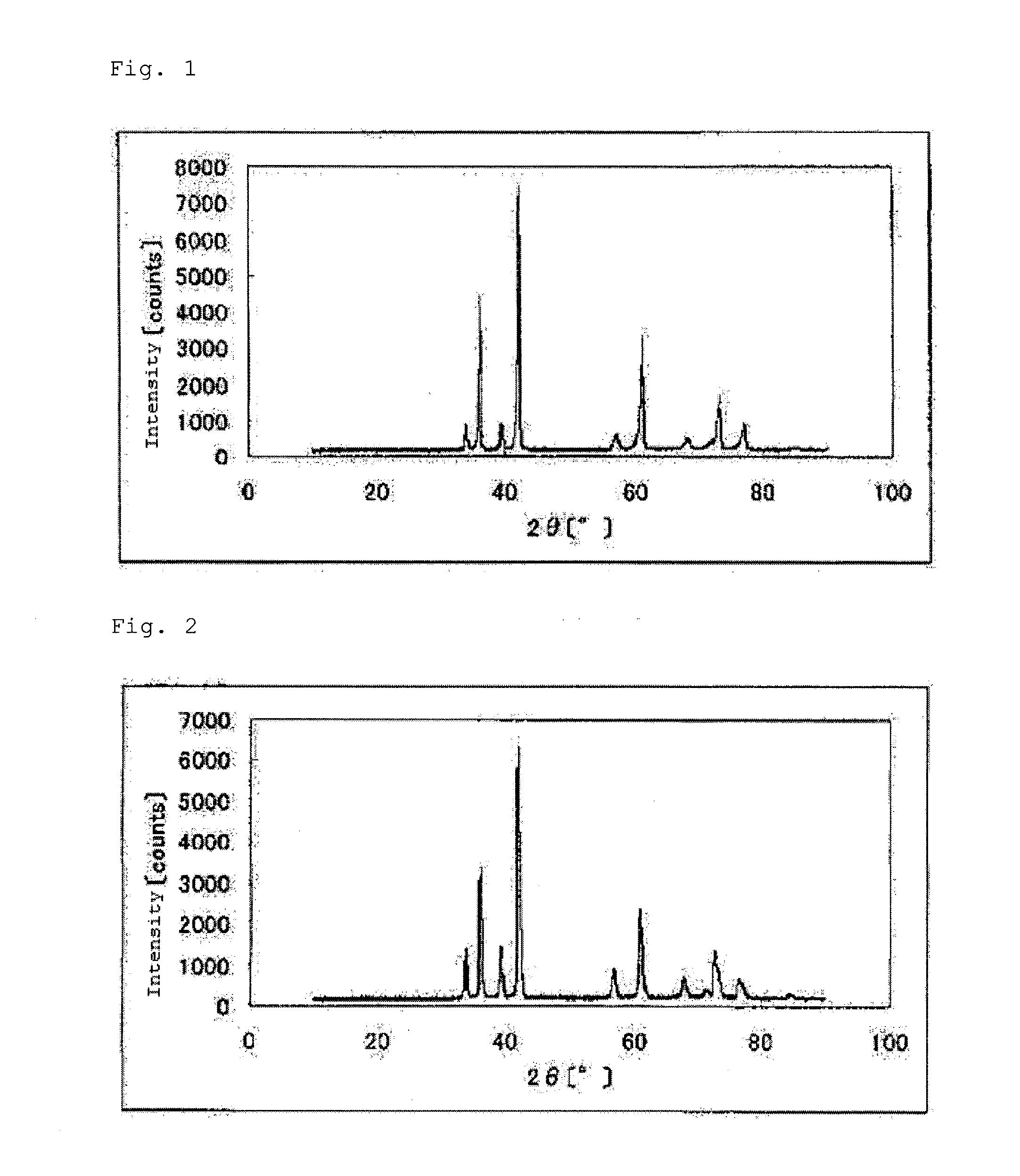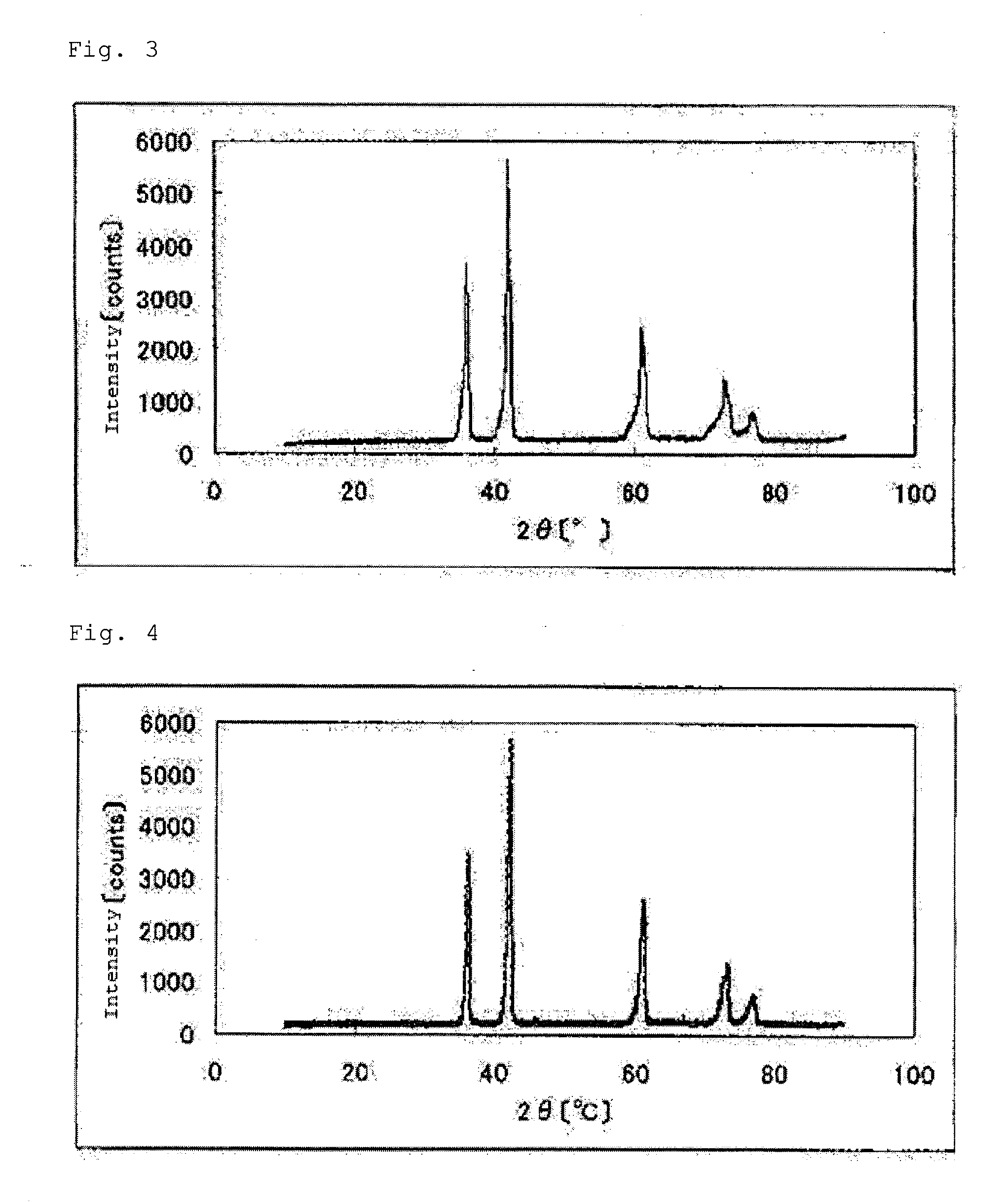Catalyst, production process therefor and use thereof
- Summary
- Abstract
- Description
- Claims
- Application Information
AI Technical Summary
Benefits of technology
Problems solved by technology
Method used
Image
Examples
example 1
1. Preparation of Catalyst
[0231]Titanium (IV) oxide (TiO2) weighing 2.87 g (39.6 mmol) and zirconium oxide (ZrO2) weighing 0.49 g (4 mmol) were mixed with 1.2 g (100 mmol) of carbon (Vulcan 72 manufactured by Cabot Corporation) and were sufficiently crushed. The resultant powder mixture was heated in a tubular furnace in a nitrogen gas at 1800° C. for 3 hours to give 3.05 g of a carbonitride (1) containing zirconium (1 mol %) and titanium. FIG. 1 shows a powder X-ray diffraction spectrum of the carbonitride (1).
[0232]The carbonitride (1) in an amount of 1.02 g was heated in the tubular furnace at 1000° C. for 1 hour while passing an argon gas containing 1% by volume of oxygen gas. As a result, 1.10 g of an oxycarbonitride containing zirconium (1 mol %) and titanium (hereinafter, also the catalyst (1)) was obtained. The results of elemental analysis of the catalyst (1) are set forth in Table 1. A powder X-ray diffraction spectrum of the catalyst (1) is shown in FIG. 7.
2. Production o...
example 2
1. Preparation of Catalyst
[0241]Titanium carbide (TiC) weighing 2.55 g (42.5 mmol), zirconium oxide (ZrO2) weighing 0.62 g (5.0 mmol) and titanium nitride (TiN) weighing 0.15 g (2.5 mmol) were mixed together and sufficiently crushed. The resultant powder mixture was heated in a tubular furnace in a nitrogen gas at 1800° C. for 3 hours to give 3.22 g of a carbonitride (2) containing zirconium and titanium. The sintered carbonitride (2) was crushed with a ball mill. FIG. 2 shows a powder X-ray diffraction spectrum of the carbonitride (2).
[0242]The carbonitride (2) in an amount of 1.02 g was treated in the same manner as in Example 1 to give 1.11 g of an oxycarbonitride containing zirconium and titanium (hereinafter, also the catalyst (2)). The results of elemental analysis of the catalyst (2) are set forth in Table 1. A powder X-ray diffraction spectrum of the catalyst (2) is shown in FIG. 8.
2. Production of Fuel Cell Electrode
[0243]A fuel cell electrode (2) was produced in the same m...
example 3
1. Preparation of Catalyst
[0247]Titanium carbide (TiC) weighing 2.70 g (45.0 mmol) and tantalum nitride (TaN) weighing 0.49 g (2.5 mmol) were mixed together sufficiently. The resultant mixture was heated in a nitrogen gas at 1800° C. for 3 hours to give 2.84 g of a carbonitride (3) containing tantalum and titanium. The sintered carbonitride (3) was crushed with a ball mill. FIG. 3 shows a powder X-ray diffraction spectrum of the carbonitride (3).
[0248]The carbonitride (3) in an amount of 1.02 g was treated in the same manner as in Example 1 to give 1.11 g of an oxycarbonitride containing tantalum and titanium (hereinafter, also the catalyst (3)). The results of elemental analysis of the catalyst (3) are set forth in Table 1. A powder X-ray diffraction spectrum of the catalyst (3) is shown in FIG. 9.
2. Production of Fuel Cell Electrode
[0249]A fuel cell electrode (3) was produced in the same manner as in Example 1, except that the catalyst (3) was used.
3. Evaluation of Oxygen Reducing...
PUM
| Property | Measurement | Unit |
|---|---|---|
| Temperature | aaaaa | aaaaa |
| Temperature | aaaaa | aaaaa |
| Percent by volume | aaaaa | aaaaa |
Abstract
Description
Claims
Application Information
 Login to View More
Login to View More - R&D
- Intellectual Property
- Life Sciences
- Materials
- Tech Scout
- Unparalleled Data Quality
- Higher Quality Content
- 60% Fewer Hallucinations
Browse by: Latest US Patents, China's latest patents, Technical Efficacy Thesaurus, Application Domain, Technology Topic, Popular Technical Reports.
© 2025 PatSnap. All rights reserved.Legal|Privacy policy|Modern Slavery Act Transparency Statement|Sitemap|About US| Contact US: help@patsnap.com



